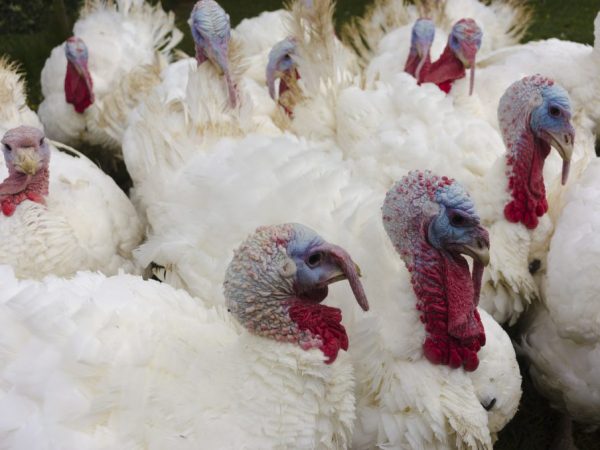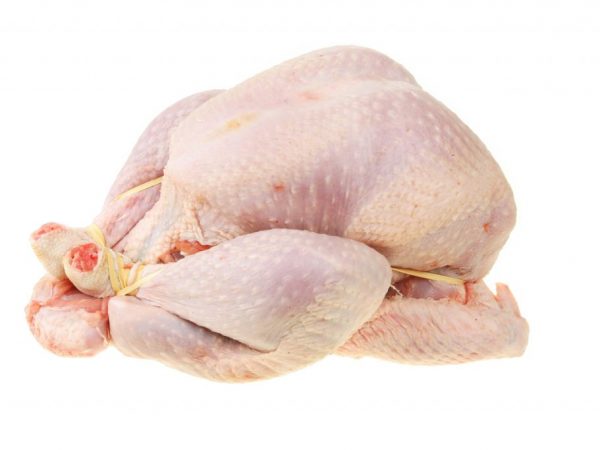Features of fattening turkeys for meat
Fattening turkeys for meat takes one of the important stages in breeding and raising poultry on a private farm, because this process directly depends on whether the bird will have time to gain the maximum possible weight by the slaughter period and has gained excellent nutritional value of dietary meat.

Features of fattening turkeys for meat
Approaches to feeding adult birds
Grow a bird on slaughter at home possible at different ages. The grown young growth is fattened up to the moment when the keeping of the poultry becomes financially unprofitable for the farm and a decision is made where to put them. Homesteads use home-based turkey fattening for meat in one of three types - meat, lard, or combined. If old culled individuals go for fattening turkeys, then a healthy turkey is suitable for meat and combined type of fattening. Usually, surplus males and young animals fall under the slaughter. Which is not subject to breeding.
A review of turkey breeds, which are more attractive for fattening for meat, showed that the North Caucasian bronze, white and bronze broad-breasted turkeys, broilers of the Big-6 breed.
The most suitable period for fattening adult livestock is from late summer (August) to mid-autumn (October). Moreover, the entire growing process is divided into two main periods:
- The first involves free range of poultry. With this content, turkeys should be fed at least three to four times a day. The diet uses wet mash and grain feed mixtures. In the absence of the possibility of free range of birds, their daily frequency of feeding increases by one more.
- The second period is the time before the immediate slaughter of the bird. During this time, the turkeys are kept only indoors and are not allowed outside. The diet of poultry in the second period of fattening for meat is dominated by feed with a greater proportion of protein components and compound feed. Dilute the nutritious diet with wet mash with flour. The amount of feed consumed daily by the turkey must be at least 0.8 kilograms.
The term for fattening adult turkeys for meat is at least 20 days - one month.
Growing turkey poults
Turkey poults for meat are grown much more often and are taken for fattening on meat as a rule, at the onset of spring, so that during the summer period they can grow and gain the desired weight. However, breeding is fundamentally different in approach from the method used for fattening adult poultry. Fattening of turkey poults for meat usually begins when they reach four months of age and resort to an intensive compulsory method, which assumes that:
- the entire period of feeding young stock, the bird is kept exclusively within the premises or in cages, not giving the opportunity to actively move,
- the room temperature does not drop below 35-37 degrees, and humidity indicators are maintained at 75 percent,
- in the first days, the room will be provided with round-the-clock lighting, which gives visibility to the bird feeders and drinkers,
- until the age of eight weeks, the stocking rate is up to 10 individuals per square meter, for the next eight weeks, their number is reduced to five, and subsequently three can be left.

Delicious meat
Turkey poults are forcibly given complementary foods twice a day - they are fed pellets made of bread and a variety of dumplings, which are prepared from milk and corn flour (there should be a fifth of it), oat flour (at least 15 percent), wheat bran and barley flour (by a quarter), industrial yeast (about 2-3 percent) and salt (1 percent). You can watch the video how to properly do this complementary food at home.
Such forced feeding, in combination with the basic feed, allows feeding the birds with an increase in the daily volume of the feed ration by about 15-25 percent and the average daily weight gain of the birds up to 100 grams.
Turkey poults are fed for meat for 15-25 days.
Composition and amounts of feed ration for young and adult birds
Wet mash is mainly composed of flour mixtures and fresh chopped herbs. Protein-containing dairy products and cottage cheese, egg leftovers are added there. You can use any grain for feeding turkeys with free grazing.
The daily ration for young livestock should be based on the following indicators for 6 - 7 or more kilograms of bird weight, respectively:
- corn, barley, oat crops - 250 - 300 - 350 grams,
- grain crop - 70 - 70 - 80 grams,
- vegetables (carrots, pumpkin, beets, turnips) - 50 - 50 - 60 grams,
- boiled potatoes - 100 - 100 - 100 grams,
- millet bran - 40 - 50 - 50 grams,
- food waste - 100 - 100 - 100 grams,
- flour - 10 - 10 - 15 grams,
- shellfish - 10 - 10 - 10 grams,
- salt - 2 - 3 - 3 grams.
Sand and gravel is provided to the bird freely. Approximately half a day before slaughtering for meat, the turkey is completely fed and transferred only to drink.
Composition and volumes of feed ration for turkey poults
Standards for fattening turkey poults should provide them daily in a percentage ratio:
- raw proteins - 22-23 percent,
- exchange energy - 13.0 MJ per kilogram,
- crude fiber - up to 3 percent,
- raw ash - up to 7 percent,
- calcium - 0.9 percent,
- phosphorus - 0.7 percent,
- sodium - 0.12 percent,
- methionine - 0.45 percent,
- lysine - 1.1 percent.
Such a mineral complex can be provided if you follow approximately the diet of turkey poults, which is indicated in the table:
| Feeding age of turkeys, in days | 1-5 | 6-10 | 11-20 | 21-30 | 31-40 | 41-50 | 51-60 | 61-90 |
| Cereals | 5 | 8 | 20 | 30 | 50 | 60 | 80 | 115 |
| Animal waste | — | 1 | 3 | 7 | 10 | 14 | 15 | 20 |
| Millet bran | 4 | 5 | 5 | 10 | 10 | 10 | 15 | 15 |
| Greens | 3 | 10 | 15 | 20 | 30 | 10 | 40 | 40 |
| Shell | — | 0,5 | 0,7 | 1,7 | 2 | 2,7 | 2,5 | 2,2 |
| Flour | — | — | 0,5 | 0,5 | 1 | 1 | 1,5 | 2,5 |
In the first five days of age, turkey poults additionally include an egg in an amount of up to 3 grams per day and cottage cheese 2 grams per day. Starting from six days of age until they reach three weeks, turkey poults increase the daily rate of cottage cheese products to 10 grams, and the egg is excluded from the diet.
Initially, during the first ten days, feeding is carried out at intervals of at least two hours.
As a feed mixture for the first two weeks, a self-prepared mash of grated eggs with the addition of corn flour or wheat flour, with chopped green onions and chopped carrots, along with millet porridge, is suitable for the first two weeks. In the first three to five days, such food is given on paper sheets, and after that the poults are transferred to self-feeding from small containers. How to cook it in a private economy, you can see in the video.
From ten days of age, turkey poults are introduced to fresh nettles and clovers, dandelions and alfalfa in unlimited quantities.
After the two-week period, poultry feed should consist of crushed cereals (about 60 percent feed volume), legumes (about 25 percent), sunflower (up to 2 percent) and chalk (up to 5 percent).
The transition to six meals a day occurs at the age of 1 month, to four meals a day - upon reaching the age of 2 months.
Four to five months after such fattening, the young turkey is ready for slaughter.


